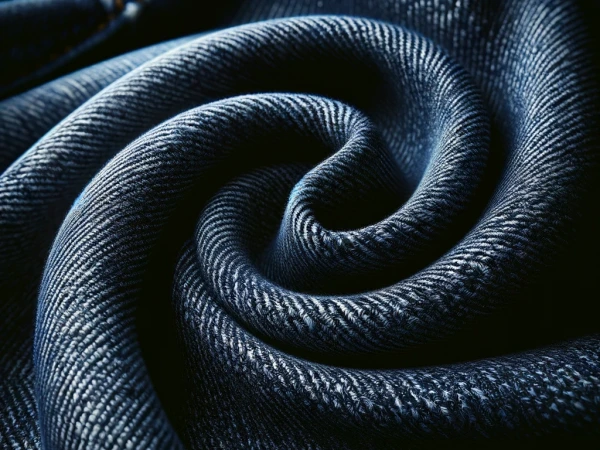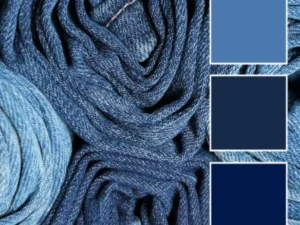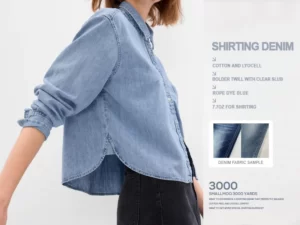I. Introduction
- Defining “Jeans Fabric” and Its Significance
Jeans fabric, universally known as denim, is more than just a material; it’s a symbol of style, durability, and cultural evolution. Originating as a humble textile for workwear, it has transcended its initial purpose to become a staple in fashion wardrobes worldwide. This guide aims to unravel the fabric’s journey, from its cotton roots to the fashion runways.
- The Historical Journey of Jeans Fabric into Denim
The story of jeans fabric begins in the 19th century, a period marked by industrial advancement and practical needs. Originally designed for miners and laborers, denim’s ruggedness and durability quickly made it a preferred material. This historical context sets the stage for understanding how jeans fabric evolved into a fashion icon.
- The Pervasive Role of Jeans Fabric in Fashion and Apparel
Today, jeans fabric is synonymous with denim, a term that conjures images of classic blue jeans, trendy jackets, and an array of fashion statements. Its versatility and adaptability have cemented its place in the fashion industry, transcending age, gender, and style preferences.
II. Composition and Manufacturing of Jeans Fabric
- Materials in Traditional and Modern Jeans Fabric
Traditionally, jeans fabric was made from 100% cotton, prized for its strength and breathability. Modern advancements have introduced blends with synthetic fibers like polyester and elastane, adding stretch and new dimensions to the fabric. This evolution highlights the industry’s response to changing fashion needs and consumer preferences.
- Weaving Jeans Fabric: The Twill Weave Technique
The unique character of jeans fabric is largely due to its twill weave. This weaving method involves passing the weft thread under two or more warp threads, creating a diagonal rib pattern. This pattern not only contributes to the fabric’s aesthetic appeal but also enhances its durability.
- The Distinctive Indigo Dyeing of Jeans Fabric
Indigo dyeing is a signature process in creating jeans fabric. Traditionally, the warp threads are dyed with indigo while the weft threads remain white, resulting in a classic blue exterior and lighter interior. The varying shades of blue, from deep navy to light sky, are achieved through different indigo dyeing techniques.
- Technological Evolution in Jeans Fabric Manufacturing
From hand-looming to high-tech machinery, the manufacturing of jeans fabric has undergone significant advancements. These technological improvements have not only increased production efficiency but also opened doors to innovative designs and sustainable practices.
III. Types and Varieties of Jeans Fabric

- Raw or Dry Denim – The Purest Form of Jeans Fabric
Raw denim, often referred to as “dry denim,” represents the jeans fabric in its purest form. This type of denim is not washed after dyeing, leaving it stiff and rich in indigo. Over time, raw denim molds to the wearer’s body and fades in a way that creates unique, personalized patterns. It’s a favorite among denim purists who appreciate its evolving nature.
- Washed Denim – A Softened Take on Jeans Fabric
In contrast, washed denim undergoes various laundering processes after dyeing, resulting in a softer texture and faded appearance. This category includes a range of styles, from lightly washed to heavily distressed, catering to diverse fashion tastes. Washed denim’s popularity lies in its instant comfort and ready-to-wear aesthetic.
- Stretch Denim and Blends: Innovations in Jeans Fabric
The introduction of stretch denim marked a significant innovation in jeans fabric. By blending cotton with elastic fibers like spandex or elastane, stretch denim offers enhanced comfort and flexibility. This type of denim caters to a growing demand for comfort in fashion, without compromising on style.
- Selvedge Denim: The Premium Jeans Fabric
Selvage denim, recognized by its clean edge on the fabric seam, is known for its high quality and durability. Produced on traditional shuttle looms, this denim type is typically more expensive and sought after by enthusiasts for its craftsmanship and longevity.
IV. Characteristics and Qualities of Jeans Fabric

- The Unmatched Durability of Jeans Fabric
One of the most lauded characteristics of jeans fabric is its durability. Originally designed for labor-intensive work, denim is resistant to wear and tear, making it a long-lasting wardrobe staple. This resilience is a testament to the fabric’s quality and the meticulous processes involved in its creation.
- Comfort and Versatility in Jeans Fabric
Jeans fabric strikes a balance between comfort and functionality. Whether in its traditional form or as stretch denim, it offers ease of movement and adaptability to various body types. Its versatility extends to fashion as well, being a canvas for a range of styles from casual to chic.
- Aesthetic Diversity of Jean Fabric in Fashion
Denim’s aesthetic appeal lies in its ability to evolve. From classic indigo to stone washed, distressed to embroidered, jeans fabric offers endless possibilities for designers and wearers alike. This diversity makes it a perennial favorite in the fashion world.
- The Aging Grace of Jeans Fabric
Unlike most fabrics, jeans fabric is celebrated for its aging process. As it wears over time, denim develops a patina and character that is highly valued. Each pair of jeans tells a story, becoming more personalized with every wear.
V. Practical Uses and Applications
- Jeans: The Quintessential Use of Jeans Fabric
The most iconic use of jeans fabric is, undoubtedly, in crafting jeans. Evolving from workwear to a fashion staple, jeans come in various styles – skinny, bootcut, straight, boyfriend, and more, each offering a different aesthetic and appeal. This versatility has made jeans a ubiquitous garment in wardrobes around the world.
- Expanding the Horizon: Jeans Fabric in Various Products
Beyond jeans, the fabric has found its way into other fashion items like jackets, skirts, dresses, and even accessories like bags and hats. Its appeal also extends into home decor, with denim being used for upholstery, cushions, and other textile accents, showcasing its versatility beyond traditional clothing.
- Jeans Fabric and Sustainable Fashion
In recent years, jeans fabric has become a significant player in the sustainable fashion movement. With an emphasis on durability and timeless style, it aligns with the principles of slow fashion. Additionally, innovations in eco-friendly dyeing and water-conserving manufacturing processes are making jeans fabric a more sustainable choice.
VI. The Global Impact of Jean Fabric
- Jeans Fabric in the International Fashion Arena
Denim’s universal appeal has made it a global phenomenon in the fashion industry. It is celebrated in high fashion runways and street style alike, transcending cultural and geographic boundaries. The fabric’s adaptability has allowed it to continuously resonate with evolving fashion trends worldwide.
- Cultural Resonance of Jeans Fabric Worldwide
Jeans fabric holds a unique place in different cultures, often symbolizing rebellion, freedom, and youth. It’s a fabric that has been embraced by various subcultures and movements, making it not just a fashion statement but a cultural icon.
- Economic Significance of Jeans Fabric Production
The production of jeans fabric is a significant economic driver in the textile industry. Major fashion brands and small-scale artisans alike contribute to a vibrant global market, with countries like China, Bangladesh, and the United States being key players in its production and export.
VII. Future Trends in Jean Fabric
- Cutting-edge technologies in Jeans Fabric Production
The future of jeans fabric production is leaning towards technology and sustainability. Innovations like laser printing, ozone washing, and organic cotton are revolutionizing how jeans fabric is produced, making it more environmentally friendly and efficient.
- The Evolving Fashion Trends of Jeans Fabric
As fashion evolves, so does the use of jeans fabric. We’re seeing trends like upcycled denim, high-tech blended fabrics, and a return to vintage styles, indicating that jeans fabric will continue to be a vital and dynamic player in the fashion industry.
- Eco-friendly Practices in Jeans Fabric Industry
Sustainability is becoming increasingly crucial in the jeans fabric industry. From water recycling to the use of natural dyes and reduction in chemical usage, the industry is moving towards more responsible production practices, reflecting a growing consumer awareness and demand for sustainable fashion.
VIII. Conclusion
- Summarizing the World of Jeans Fabric
Jeans fabric, or denim, is not just a textile; it’s a phenomenon that intertwines fashion, culture, and sustainability. From its rugged beginnings to its status as a fashion essential, it has proven its versatility and endurance.
- Celebrating the Timeless Appeal of Jean Fabric
The continuous popularity and reinvention of jeans fabric in various forms underscore its timeless appeal. It’s a fabric that adapts, evolves, and remains relevant, no matter the changing trends.
- The Ongoing Evolution of Jeans Fabric in Fashion
As we look to the future, jeans fabric stands at the forefront of fashion innovation and sustainability. Its journey from a miner’s workwear to a symbol of style and cultural expression is a testament to its enduring legacy.





